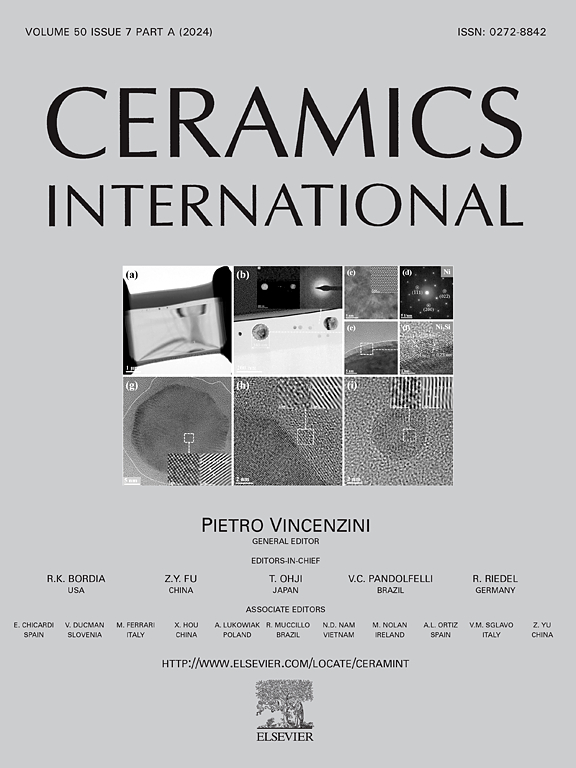Enhancing the performance of CaTiO3-GDC heterostructure electrolytes in LT-CFCs
IF 5.6
2区 材料科学
Q1 MATERIALS SCIENCE, CERAMICS
引用次数: 0
Abstract
Designing ceramic fuel cells (CFCs) with fast ionic conduction and superior electrochemical performance at low temperatures is critical for advancing hydrogen applications. Here, we developed a heterostructure electrolyte by combining the ionic conductor Gd0.1Ce0.9O2 (GDC) with the semiconductor material CaTiO3 (CTO) to shape into the composite heterostructure (semiconductor ionic heterostructure) CTO-GDC. The designed heterostructure with different fermi levels established the depletion zone due to the redistribution of charges at the interface, leading to enhancement of the ionic conduction; meanwhile, the established built-in electric field suppresses the electronic conduction speed of the ion's transportation at the interface of the constructed heterostructure (CTO-GDC). The formation of heterostructure introduces a number of oxygen vacancies, as confirmed via x-ray photoelectron spectroscopy (XPS) and electron paramagnetic resonance (EPR), benefiting the transportation of ions in the composite heterostructure. The prepared composite heterostructure shows the highest power output of 810 mW/cm2 at a low operational temperature of 520 °C. The CTO-GDC shows high ionic conductivity of 0.17 S cm−1 at 520 °C and low activation energy of 0.785 eV at 520-420 °C. The composite containing a 50 % molar ratio of GDC and CTO demonstrated exceptional performance by successfully inhibiting electron transit, improving ionic conductivity, and achieving outstanding power output. The enhanced ionic conductivity with low activation energy of composite heterostructure suggests that designing a heterostructure seems an efficient approach to fuel cell application.

提高CaTiO3-GDC异质结构电解质在LT-CFCs中的性能
设计具有快速离子传导和低温下优异电化学性能的陶瓷燃料电池(CFCs)是推进氢应用的关键。本文将离子导体Gd0.1Ce0.9O2 (GDC)与半导体材料CaTiO3 (CTO)结合,形成复合异质结构(半导体离子异质结构)CTO-GDC,开发了一种异质结构电解质。设计的具有不同费米能级的异质结构由于在界面处电荷的重新分配而建立了耗尽区,导致离子传导增强;同时,建立的内置电场抑制了离子在构建异质结构(CTO-GDC)界面上输运的电子传导速度。通过x射线光电子能谱(XPS)和电子顺磁共振(EPR)证实,异质结构的形成引入了许多氧空位,有利于离子在复合异质结构中的传输。所制备的复合异质结构在520℃低温下的最高输出功率为810 mW/cm2。CTO-GDC在520℃时离子电导率为0.17 S cm−1,520 ~ 420℃时活化能为0.785 eV。GDC和CTO摩尔比为50%的复合材料表现出优异的性能,成功地抑制了电子传输,提高了离子电导率,并实现了出色的功率输出。复合异质结构具有较低的活化能和较强的离子电导率,表明设计异质结构是燃料电池应用的有效途径。
本文章由计算机程序翻译,如有差异,请以英文原文为准。
求助全文
约1分钟内获得全文
求助全文
来源期刊

Ceramics International
工程技术-材料科学:硅酸盐
CiteScore
9.40
自引率
15.40%
发文量
4558
审稿时长
25 days
期刊介绍:
Ceramics International covers the science of advanced ceramic materials. The journal encourages contributions that demonstrate how an understanding of the basic chemical and physical phenomena may direct materials design and stimulate ideas for new or improved processing techniques, in order to obtain materials with desired structural features and properties.
Ceramics International covers oxide and non-oxide ceramics, functional glasses, glass ceramics, amorphous inorganic non-metallic materials (and their combinations with metal and organic materials), in the form of particulates, dense or porous bodies, thin/thick films and laminated, graded and composite structures. Process related topics such as ceramic-ceramic joints or joining ceramics with dissimilar materials, as well as surface finishing and conditioning are also covered. Besides traditional processing techniques, manufacturing routes of interest include innovative procedures benefiting from externally applied stresses, electromagnetic fields and energetic beams, as well as top-down and self-assembly nanotechnology approaches. In addition, the journal welcomes submissions on bio-inspired and bio-enabled materials designs, experimentally validated multi scale modelling and simulation for materials design, and the use of the most advanced chemical and physical characterization techniques of structure, properties and behaviour.
Technologically relevant low-dimensional systems are a particular focus of Ceramics International. These include 0, 1 and 2-D nanomaterials (also covering CNTs, graphene and related materials, and diamond-like carbons), their nanocomposites, as well as nano-hybrids and hierarchical multifunctional nanostructures that might integrate molecular, biological and electronic components.
 求助内容:
求助内容: 应助结果提醒方式:
应助结果提醒方式:


